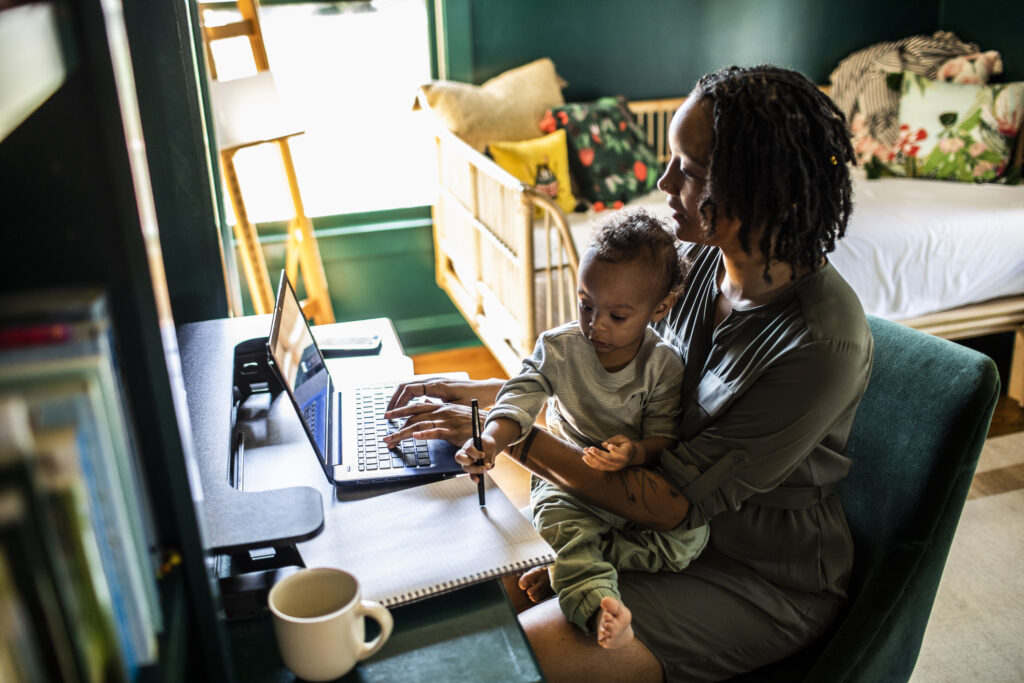
In the wake of the COVID-19 pandemic, it has proved challenging to get an accurate assessment of women’s relationship to the workplace.
- Two years ago, pandemic-era lockdowns began a mass exodus in the workplace, as women left in droves—either choosing or forced to prioritize caregiving.
- Towards the end of 2022, the effects of the pandemic started to wane, and children returned to in-person school and parents to in-person (or hybrid) work. But women’s labor force participation still lagged behind pre-pandemic numbers.
- In January of this year, the Biden administration announced the end of the COVID-19 public health emergency, effective last month.
- By February, The Center for American Progress reported that recent economic recovery had bumped women’s employment among workers aged 24–54, despite persistent pay gaps and occupational segregation.
- Today, the U.S. is still feeling the effects of the COVID-era labor shortage: The U.S. Chamber of Commerce reported last month that workforce participation remains below pre-pandemic levels. But employment today is growing at a healthy rate, and women do seem to be largely back at work.
The variability in numbers, disparate date sets, and unpredictability month by month in how this story is understood, begs the question: As official states of emergency expire, what—if anything—has changed?
In this landscape, many of the same concerns still exist, from wages to sexism to inadequate support infrastructure, and we have yet to see how the end of Roe will play out long term.
And, new challenges have arisen, like managing proximity bias in hybrid work models. At the same time, there are also some hopeful barometers of progress—including employer-sponsored health benefits addressing menopause care and legal work being doing to negate impacts of forced arbitration on women.
Women Are Embracing Job Mobility—Even in the Face of Legacy Problems
Heather Odendaal is the founder and CEO of WNorth, an organization that supports women who are both trying to reach executive level positions and those who are already on a senior leadership track. During lockdown, Odendaal observed women trying to hold on to what they had, unwilling to make a career change if that meant introducing additional challenges into their lives.
“We’re seeing a lot of movement, now,” she said. “This new year felt more positive, and there is more interest in career advancement for women, plus an appetite for mobility.”
Still, Odendaal says that in looking at the last decade, essentially nothing has improved when it comes to childcare, and she worries about women who are choosing remote or hybrid work losing out on the advancement that can come with being present in the office. While the flexibility to not be required on-site is extremely valuable, at the same time, it can decrease opportunities for mentorship, reduce visibility and feel isolating. Proximity bias—the perception from managers that those who are at their physical desks in the physical office are simply working harder—is a real threat. These workers, even if not intentionally being left out of projects and promotions, are often times forgotten about, being out of site and therefore out of mind. And these workers are (you guessed it) often women, who still perform the bulk of family care work.
“Childcare is not the whole story, but many women do feel like the tradeoff of working from home is worth it, even if exposes them [to] those proximity bias factors,” she said. “My question is: Why should there even have to be a tradeoff?”
New Healthcare Benefits Address Realities of Mid-Life Working Women
As women reach mid-life, earning potential is often finally on the upswing. At the same time, the door for fertility may be swinging shut. Women at this age, while often at the top of the game professionally, might be pursuing a first or final pregnancy, or experiencing tangible signs of menopause.
“We understand that diverse and inclusive teams have better outcomes,” said Jenny Pigott, chief people officer at Appnovation, a software development agency with over 400 employees.
In the post-pandemic era, Appnovation has instituted a supplemental leave for those who need support for fertility treatments or menopausal care. Knowing that both can be a journey, while it is a newer policy, the company is taking a long view in how prioritizing women’s health and women’s concerns can lead to a more inclusive working environment for all employees. The company also provides abortion care as a standard benefit, including access to travel funds if needed.
Forget quiet quitting: This is the era of what McKinsey calls “the great breakup.” Women are demanding more from their workplaces. Workplace culture concerns—namely, flexibility and wanting a commitment to diversity from employers—is tellingly the third ranked driver for workplace attrition among women, behind lack of opportunity for advancement, and burnout, respectively.
“There has to be positive, long-term change,” said Pigott. “Both fertility and menopause will affect many of our colleagues, either directly or as a partner.”
Not addressing gender disparity in employment may cost the global economy $13 trillion by 2030, the McKinsey report from October notes.
Pushing Back on Employment Practices That Disproportionally Impact Women and People of Color
Recent tech layoffs using the “last in, first out” model have undone the gains made in recent years by women and people of color. In the most generous reading, many of these companies were genuinely trying to increase diversity in hiring—and executed on it reasonably well during the post-lockdown hiring boom. Yet, as demand for online services shrunk and precipitated shrinking payrolls, the old models ultimately prevailed.
Hand in hand with legacy policy like “last in, first out,” are non-disclosure agreements (NDAs) and the concept of forced arbitrage, which revokes an employee’s right to take a dispute with their employer to court, and relies instead on a company-selected arbiter to resolve conflicts.
“In theory, companies are trying to protect their intellectual property and proprietary information,” said Dr. Kristin Hull, founder at Nia Impact Capital, which only invests in organizations who have women in leadership positions. “However, in practice, concealment clauses like NDAs and forced arbitrage can suppress an employee’s ability to speak out against discrimination and make it very unlikely for an employee to get a fair hearing: The arbiters are not just selected by the employer, but also on their payroll.”
Notably, these are not policies workers can simply opt out of—and even if they may not personally be bound by NDA, a manager might.
Hull says the post-COVID landscape is an opportune time for boards to reconsider how concealment clauses are playing out in their organizations, and in particular how women and people of color are effected. Improving transparency is not only good for workplace culture, but also for the bottom line. In the COVID era, resistance to concealment overreach has picked up steam, including a $310 million settlement from Alphabet over sexual harassment and a $22.5 million settlement paid by Pinterest for gender discrimination.
Last year, Hull and Nia Impact Capital took a fight with Apple over concealment clauses all the way to the SEC—and won. She encourages other investment firms to use their financial leverage to effect change, even up to the point of divesting.
Ultimately, despite the huge economic threat of the childcare crises, and the reality that pandemic job losses, both voluntary and involuntary, impacted women the most and exacerbated gender disparities, in the current labor climate, we are still making our way. We are, in fact, still fighting.
Up next:
U.S. democracy is at a dangerous inflection point—from the demise of abortion rights, to a lack of pay equity and parental leave, to skyrocketing maternal mortality, and attacks on trans health. Left unchecked, these crises will lead to wider gaps in political participation and representation. For 50 years, Ms. has been forging feminist journalism—reporting, rebelling and truth-telling from the front-lines, championing the Equal Rights Amendment, and centering the stories of those most impacted. With all that’s at stake for equality, we are redoubling our commitment for the next 50 years. In turn, we need your help, Support Ms. today with a donation—any amount that is meaningful to you. For as little as $5 each month, you’ll receive the print magazine along with our e-newsletters, action alerts, and invitations to Ms. Studios events and podcasts. We are grateful for your loyalty and ferocity.





